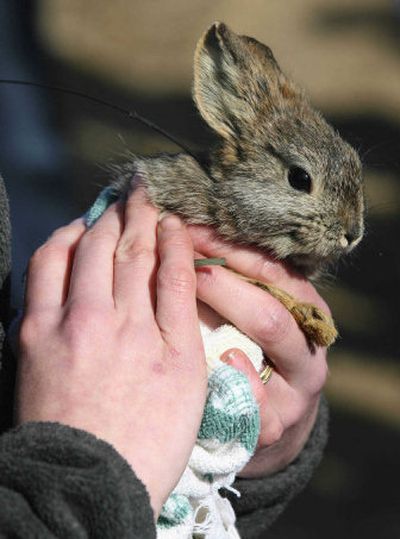Pygmy rabbits get big chance

EPHRATA, Wash. – Wildlife officials Tuesday released 20 Columbia Basin pygmy rabbits that were raised in captivity to a sagebrush-covered area of central Washington state where their ancestors roamed before teetering on the edge of extinction.
The pygmy rabbits were born and raised at Washington State University and the Portland Zoo in Oregon and are descendants of the last known wild rabbits, caught in 2002 for a captive breeding program intended to restore the endangered species.
The effort is similar to the breeding programs that brought back the California condor, said Ren Lohoefener, Pacific regional director of the U.S. Fish and Wildlife Service in Portland.
“Any time you can bring something back from zero and re-establish it, it’s cause to celebrate,” he said. “This may be harder to do than with condors, because a lot more things eat bunnies than condors. If it works here, maybe it can work in other areas.”
The rabbits were released in the Sagebrush Flats area about 18 miles northwest of Ephrata, part of a five-county range that was the original habitat of the tiny sagebrush-eating rabbits. They are the only species of rabbits in the United States to dig their own burrows.
Pygmy rabbits are still found in the West’s Great Basin, but the isolated Columbia Basin group is considered to be an evolutionary distinct population, said Rod Sayler, a Washington State University associate professor of natural resource sciences who leads the captive breeding project.
The Northwest Trek Wildlife Park near Tacoma also participates in the captive breeding program, which has produced about 90 pygmy rabbits, including the 20 released Tuesday.
None of the purebred Columbia Basin pygmy rabbits is believed to remain in the wild, said Tom Buckley of the U.S. Fish and Wildlife Service. Only three purebred descendants of the original wild rabbits remain at the captive breeding sites, Sayler said.
Columbia Basin pygmy rabbits were mated with more genetically diverse Idaho pygmy rabbits, and their offspring have at least 75 percent of the Columbia pygmy bloodlines, said Lisa Shipley, Sayler’s colleague at WSU.
An immediate result was that the crossbred rabbits became better breeders and more of their young survived, Sayler said.
“We found out they were suffering from severe inbreeding depression,” Sayler said. “No matter what we did, they just weren’t reproducing well. Believe me, we tried everything.”
“What that did was, it added in some genetic diversity. That population had been isolated for thousands of years,” he said. “We added just enough to help them along and reproduction picked back up.”
The reason the Columbia Basin rabbits declined is not known, although scientists suspect inbreeding among such a small population was a major factor. Range fires, farming, disease and predators also are thought to have taken their toll, said Madonna Luers of the Washington Department of Fish and Wildlife, which is cooperating with its federal counterparts in the program.
The tiny rabbits – not much bigger than a man’s hand – were released into a barren sagebrush landscape.
The dozen males and eight females were placed in artificial burrows made of 20-foot-long perforated plastic irrigation pipes until they get used to the place and dig their own.
Each wore a tiny radio transmitter the size of a watch battery to help scientists track its movements.
The Columbia Basin pygmy rabbit – scientific name Brachylagus idahoensis – is the country’s smallest native rabbit. It was listed as an endangered species under the federal Endangered Species Act in 2003. Surveys in 2004 found none left in traditional areas.
The rabbits were released on public lands that are part of about 10,000 acres the state Fish and Wildlife and Natural Resources departments have set aside for them.
Nearby private land owners also are important to the rabbit recovery effort, state Fish and Wildlife Director Jeff Koenigs said.
Rancher Dave Billingsley is one of three property owners who signed “safe harbor” agreements with federal fish and wildlife agencies in case the rabbits spread to their land.
“I look at it as an insurance policy,” Billingsley said. “They surveyed the land and found there are no rabbits now. Anything that shows up, we’re not responsible for it.”
Buckley said the agreements ask landowners to tell federal agencies when pygmies are spotted so other uses can be suggested for the land, or the rabbits can be moved elsewhere.
“The areas that are left of good soils and sagebrush are pretty limited,” Buckley said. “With the cooperation of landowners, it allows us to expand the rabbits’ habitat.”